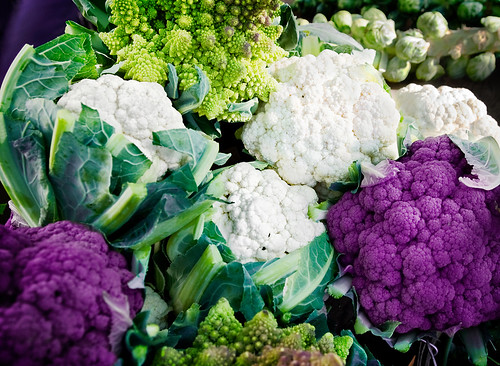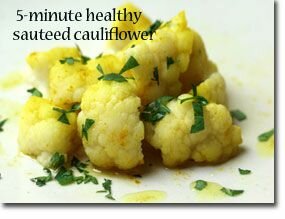Cropedia:Cauliflower
Cauliflower
" "
"
Source: http://www.flickr.com/photos/57833357@N00/2396095999/
Years grown at UBC Farm/LFSOG: 10
Growing conditions
Before the end of spring, allow the seedlings to germinate indoors 4 to 6 weeks at 7˚C to 29˚C (45˚F to 85˚F) [1]. It will take 4 to 7 days for sprouts to emerge [1]. Once the outside soil temperature is at least 10˚C (50˚F), the seedlings can be transplanted outdoors [1]. The plant itself requires full sun exposure to achieve optimum yield [1]. In order for cauliflower to form into a decent curd (the white flower portion of the plant), it needs to grow quickly in the beginning [2].
It is best to use soil that is well drained, fertile and contains high amount of organic matter, with a pH of 6.0 to 7.5 [1]. It should be watered generously on a consistent basis [1]. If a slow growth is observed, low nitrogen fertilizer can be applied to the surface of soil [1]. However, do not use low nitrogen fertilizer in excess because this will result in hollow stems [1].
Blanching
- If white varieties are being grown, cover the forming curd with one of its large leaf to protect it from the sun; this is called blanching [1]. If the curd is exposed to too much sunlight, its color will change from white to yellowish [2].
Transplanting
- Put seeds about 1/2 cm deep in sterile starting mix [1]. Separate seedlings into individual 8 cm (3”) pots after 3 weeks [1]. After 5-8 weeks, the plant should have 4-8 leaves; this indicates it is ready to be planted in the garden and it should be sown deeper 1/2" to 3/4” deep) into the soil, and about 45 cm (18”) apart [1].
Direct Seeding
- Place 3-4 seeds in each desired spot when the temperature is above 10˚C [1]. To grow large curds, use wide spacings; hence, smaller spacings will produce smaller curds [1]. For example, space 45-60 cm (18-24”) apart in rows 45-60cm apart [1, 2].
Note: If small heads are produced, this indicates that the plant is under stress [2].
Harvesting
- Once the curd starts forming, check the plant everyday [1] because it can go from being a nubbin to being overblown in a week to 10 days [2]. The plant can be cut when the florets are just beginning to separate because this indicates that the flavour is fully developed and the size is at its maximum [1].
The disease and insect problems of cauliflower or other Cole crops can be reduced via crop rotation more than once every 3-4 years [1].
Diseases
- The common disease problems of cauliflower are similar to cabbage [1]. Mulch can be used to protect the roots, reduce weed competition and conserve moisture [1].
Pests
- The early varieties, tends to be more sensitive to root maggots because of its shallow roots [2]. Floating row covers can be used help protect from early insect infestations [1].
Seasonality
Cauliflower grows best during the cool season [1]. Thus, it is best to grow from early March to mid June [1]. Overwintering cauliflower is easier to grow, but the main risk that affects its yield is how cold the winter will be [2].
Nutritional Information
Cauliflower is high in B6 vitamins, folate, vitamin C, and it is a source of dietary fibre [1].
The following nutrition facts is based on raw cauliflower.
| Nutrition Facts/Valeur Nutritive | |
|---|---|
| Serving Size: 50 g | |
| Amount Per Serving | %Daily Value* |
| Calories 100g (raw) | |
| Total Fat 0g | 0% |
| Saturated Fat 0g | 0% |
| Trans Fat 0g | |
| Cholesterol 0mg | |
| Sodium 30mg | 1% |
| Total Carbohydrate 5g | 2% |
| Dietary Fiber 2g | 8% |
| Sugars 2g | |
| Protein 2g | |
| Vitamine A | 0% |
| Vitamine C | 80% |
| Calcium | 2% |
| Iron | 0% |
| * % Daily value based on a 2000 calorie diet | |
Note: Nutritional information derived from data provided by Health Canada.
Recipes
This vegetable can generally be incorporated into any type of dish. It can be fried, stir-fried, steamed, sauteed, roasted, baked, mashed or simply eaten raw. Below are some recommended recipes:

This simple veggie recipe pairs well as a side dish and its combination of turmeric imparts a distinct flavor to it. One serving of this dish is loaded with vitamins - it provides 181% DV for vitamin C, 46% DV for vitamin K, and 33% DV for folate.

At first glance, these cauliflower fritters may be mistaken for being scraps of fried bits. But these are actually florets that are basked in a cayenne pepper and parmesan batter prior to be fried golden brown. This is served with a rich greek yogurt dip seasoned with lemon juice, and garlic. To add some kick to the dip, try a dash of cayenne pepper.

An exceptionally tasty and cheesy baked cauliflower dish that can be a lighter substitute to macaroni cheese. To add some green vegetables to this dish, try broccoli.

A spicy Indian recipe packed with hotness and the sweetness of coconut cream. Serve with naan, because this is finger-licking good.
Additional usage inventory
- Biotin, a water soluble vitamin found in cauliflower has been linked to controlling dandruff and it also helps thicken nails, which reduces splitting and cracking [3].
- Munching on raw cauliflower before bed may help stop jaw-clenching while sleeping [3].
Academic connections
At UBC, it played a role in an inconclusive biofertilizer study several years ago.
References
[1] West Coast Seeds. (2010). How to grow cauliflower. Retrieved March 20, 2010, from http://www.westcoastseeds.com/product/Vegetable-Seeds/Cauliflower
[2] Solomon, S. (5th Ed.). (2000). Growing vegetables west of the cascades: the complete guide to natural gardening. Seattle, WA: Sasquatch Books.
[3] Grotto, D. (2007). 101 foods that could save your life. New York, NY: Random House, Inc.
Additional notes
- Cauliflower, also known as Brassica oleracea var. botrytis, belongs to the Brassicaceae (mustard) Family. Though part of its name is flower, it is not a flower. Cauliflowers are actually a bunch of stems.
- Cauliflower first originated from Cyprus, and then it spread across Europe. Currently, China and India are the largest producers of this crop, and in Europe, Spain is the biggest grower. In the US, California is the primary producer.
- An orange cauliflower, developed in Canada, contains 25 times the level of vitamin A of the regular white varieties [1]. This is called the orange “cheddar” cauliflower and its color indicates that it contains high levels of beta-carotene [1].
- “Purple cauliflower” is actually a cauliflower/broccoli cross; it tastes more like broccoli but looks like cauliflower [2].
- To pick a decent cauliflower, select firm, compact, creamy, white heads with florets bunched closely together and its leaves should be bright green and crisp [2]. If it has a yellow tinge, this indicates over maturity [2].
- To retain the freshness of cauliflower during storage, refrigerate it unwashed and store it in a plastic bag with its head turned downwards [3]. By doing so, this will avoid moisture build up and rapid spoiling [3].
- Cauliflower grows well with the following plants: basil, bean, dill, garlic, hyssop, lettuce, marigold, mint, onion, rosemary, sage, and thyme [1].
Lessons from UBC Farm
- Difficulty of Growing: 4 (on a scale of 1 to 5, where 1 is the easiest and 5 is the most difficult)
- Similar to growing broccoli but more challenging, stressed plants produce very small heads (Tim Carter, UBC Farm Production Coordinator, personal communication, March 16, 2010).